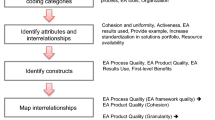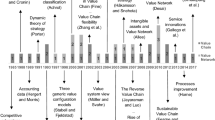Abstract
The World-Wide-Web is fast becoming a crucial medium for electronic commerce. Many companies are now involved in on-line retailing of goods and services to consumers through the Web. In some industries, business partnerships are being fostered in order to broaden the scope of their markets. One example is the telecommunications industry, where changes in business structure, spirited by deregulation, have resulted in alliances amongst different communications providers, including new players like the utilities and entertainment providers. In this environment, business processes may involve multiple co-operating entities and, supporting such interorganizational business processes can be achieved through the use of workflow management systems. In this paper, we present an approach for designing interorganizational workflows that supports co-operation of business partners, while preserving the autonomy of the partner organizations.
Similar content being viewed by others
References
van der Aalst, W. (1998). “The Application of Petri Nets to Workflow Management.” The Journal of Circuits, Systems and Computers 8(1), 21–66.
van der Aalst, W. (1999). “Interorganizational Workflows: An Approach Based on Message Sequence Charts and Petri Nets.” Systems Analysis Modelling Simulation 34(3), 335–367.
van der Aalst, W. (2000a). “Inheritance of Interorganizational Workflows: How to Agree to Disagree Without Loosing Control?” BETA Working Paper Series, WP 46, Eindhoven University of Technology, Eindhoven.
van der Aalst, W. (2000b). “Process-oriented Architectures for Electronic Commerce and Interorganizational Workflow.” Information Systems 24(8), 639–671.
van der Aalst, W. and K. Anyanwu. (1999). “Inheritance of Interorganizational Workflows to Enable Business-to-Business E-commerce.” In Proceedings of the Second International Conference on Telecommunications and Electronic Commerce (ICTEC'99), Nashville, TN, pp. 141–157.
van der Aalst, W. and T. Basten. (1997). “Life-Cycle Inheritance: A Petri-Net-Based Approach.” In P. Azéma and G. Balbo (eds.), Application and Theory of Petri Nets 1997, Lecture Notes in Computer Science, Vol. 1248. Berlin: Springer, pp. 62–81.
van der Aalst, W. and T. Basten. (2002). “Inheritance of Workflows: An Approach to Tackling Problems Related to Change.” Theoretical Computer Science 270(1-2), 125–203.
van der Aalst, W., J. Desel, and A. Oberweis (eds). (2000). Business Process Management: Models, Techniques, and Empirical Studies, Lecture Notes in Computer Science, Vol. 1806. Berlin: Springer.
van der Aalst, W. and M. Weske. (2001). “The P2P approach to Interorganizational Workflows.” In Proceedings of the 13th International Conference on Advanced Information Systems Engineering (CAiSE'01), Lecture Notes in Computer Science, Vol. 2068. Berlin: Springer, pp. 140–156.
Adam, N., V. Atluri, and W. Huang. (1998). “Modeling and Analysis of Workflows using Petri Nets.” Journal of Intelligent Information Systems10(2), 131–158.
Adams, E.K. and K.J. Willetts. (1996). The Lean Communications Provider: Surviving the Shakeout through Service Management Excellence. McGraw-Hill.
Basten, T. (1998). “In Terms of Nets: System Design with Petri Nets and Process Algebra.” PhD Thesis, Eindhoven University of Technology, Eindhoven, The Netherlands.
Basten, T. and W. van der Aalst. (2001). “Inheritance of Behavior.” Journal of Logic and Algebraic Programming 47(2), 47–145.
Benjamin, R. and R. Wigand. (1995). “Electronic Markets and Virtual Value Chains on the Information Superhighway.” Sloan Management Review, 62–72.
Berthelot, G. (1986). “Checking Properties of Nets Using Transformations.” In G. Rozenberg (ed.), Advances in Petri Nets 1985, Lecture Notes in Computer Science, Vol. 222. Berlin: Springer, pp. 19–40.
Berthelot, G. (1987). “Transformations and Decompositions of Nets.” In W. Brauer, W. Reisig, and G. Rozenberg (eds.), Advances in Petri Nets 1986 Part I: Petri Nets, Central Models and Their Properties, Lecture Notes in Computer Science, Vol. 254. Berlin: Springer, pp. 360–376.
Bons, R., R. Lee, and R. Wagenaar. (1998). “Designing Trustworthy Interorganizational Trade Procedures for Open Electronic Commerce.” International Journal of Electronic Commerce 2(3), 61–83.
Cole, M. (1999). Telecommunications. Prentice-Hall.
Desel, J. and J. Esparza. (1995). Free Choice Petri Nets, Cambridge Tracts in Theoretical Computer Science, Vol. 40. Cambridge, UK: Cambridge University Press.
Dodd, A.Z. (1997). The Essential Guide to Telecommunications. Prentice-Hall.
Dutta, A. (1997). “The Physical Infrastructure for Electronic Commerce in Developing Nations: Historical Trends and the Impact of Privatization.” International Journal of Electronic Commerce 2(1), 61–83.
Ellis, C. (1979). “Information Control Nets: A Mathematical Model of Office Information Flow.” In Proceedings of the Conference on Simulation, Measurement and Modeling of Computer Systems. Boulder, CO: ACM Press, pp. 225–240.
Ellis, C. and G. Nutt. (1993). “Modelling and Enactment of Workflow Systems”. In M.A. Marsan (ed.), Application and Theory of Petri Nets 1993, Lecture Notes in Computer Science, Vol. 691. Berlin: Springer, pp. 1–16.
van Glabbeek, R. and W. Weijland. (1996). “Branching Time and Abstraction in Bisimulation Semantics.” Journal of the ACM43(3), 555–600.
Grabowski, J., P. Graubmann, and E. Rudolph. (1993). “Towards a Petri Net Based Semantics Definition for Message Sequence Charts.” In O. Faergemand and A. Sarma (eds.), SDL'93-Using Objects, Proceedings of the Sixth SDL Forum. North-Holland, pp. 179–190.
Grefen, P., K. Aberer, Y. Hoffner, and H. Ludwig. (2001). “CrossFlow: Cross-Organizational Workflow Management in Dynamic Virtual Enterprises.” International Journal of Computer Systems, Science, and Engineering 15(5), 277–290.
Jablonski, S. and C. Bussler. (1996). Workflow Management: Modeling Concepts, Architecture, and Implementation. International Thomson Computer Press.
Kalakota, R. and A. Whinston. (1996). Frontiers of Electronic Commerce. Reading, MA: Addison-Wesley.
Kang, M., J. Froscher, A. Sheth, K. Kochut, and J. Miller. (1999). “A Multilevel Secure Workflow Management System.” In Proceedings of the 11th International Conference on Advanced Information Systems Engineering (CAiSE '99), Lecture Notes in Computer Science, Vol. 1626. Berlin: Springer.
Kindler, E., A. Martens, and W. Reisig. (2000). “Inter-Operability ofWorkflow Applications: Local Criteria for Global Soundness.” In W. Aalst, J. Desel, and A. Oberweis (eds.), Business Process Management: Models, Techniques, and Empirical Studies, Lecture Notes in Computer Science, Vol. 1806. Berlin: Springer, pp. 235–253.
Koulopoulos, T. (1995). The Workflow Imperative. New York: Van Nostrand Reinhold.
Lazcano, A., G. Alonso, H. Schuldt, and C. Schuler. (2001). “The WISE Approach to Electronic Commerce.” International Journal of Computer Systems, Science, and Engineering15(5), 345–357.
Lawrence, P. (ed.) (1997). Workflow Handbook 1997, Workflow Management Coalition. New York: John Wiley and Sons.
Lee, R. (1999). “Distributed Electronic Trade Scenarios: Representation, Design, Prototyping.” International Journal of Electronic Commerce 3(2), 105–120.
Lee, R. and R. Bons. (1996). “Soft-Coded Trade Procedures for Open-edi.” International Journal of Electronic Commerce 1(1), 27–49.
Malone, T., R. Benjamin, and J. Yates. (1987). “Electronic Markets and Electronic Hierarchies: Effects of Information Technology on Market Structure and Corporate Strategies.” Communications of the ACM 30(6), 484–497.
Merz, M., B. Liberman, and W. Lamersdorf. (1997). “Using Mobile Agents to Support Interorganizational Workflow-Management.” International Journal on Applied Artificial Intelligence 11(6), 551–572.
Merz, M., B. Liberman, and W. Lamersdorf. (1999). “Crossing Organisational Boundaries with Mobile Agents in Electronic Service Markets.” Integrated Computer-Aided Engineering 6(2), 91–104.
Reisig, W. and G. Rozenberg (eds.) (1998). Lectures on Petri Nets I: Basic Models, Lecture Notes in Computer Science, Vol. 1491. Berlin: Springer.
Rudolph, E., J. Grabowski, and P. Graubmann. (1996). “Tutorial on Message Sequence Charts.” Computer Networks and ISDN Systems 28(12), 1629–1641.
Sheth, A., W. van der Aalst, and I. Arpinar. (1999). “Processes Driving the Networked Economy: Process-Portals, ProcessVortex, and Dynamically Trading Processes.” IEEE Concurrency 7(3), 18–31.
Verbeek, H., T. Basten, and W. van der Aalst. (2001). “Diagnosing Workflow Processes Using Woflan.” The Computer Journal 44(4), 246–279.
Zwass, V. (1996). “Electronic Commerce: Structures and Issues.” International Journal of Electronic Commerce 1(1), 3–23.
Author information
Authors and Affiliations
Rights and permissions
About this article
Cite this article
van der Aalst, W. Inheritance of Interorganizational Workflows to Enable Business-to-Business E-Commerce. Electronic Commerce Research 2, 195–231 (2002). https://doi.org/10.1023/A:1016031730365
Issue Date:
DOI: https://doi.org/10.1023/A:1016031730365




